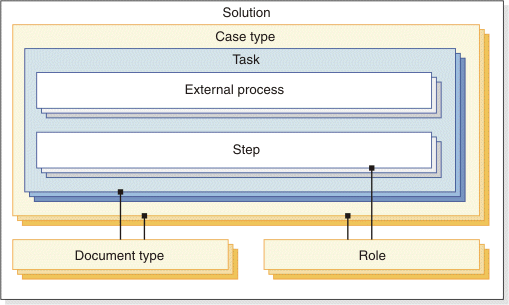Case management solution concepts
Solutions consist of case types, tasks, steps, and other components. A solution is an application that case workers use to process cases.

- Solutions
- A solution consists of one or more related case types that provide the documents, data, business processing, and routing to the case workers. For example, a solution for a human resources department might include a case type for new hires, a case type for retirement, and a case type for employee termination.
- Case types
- Case types define the tasks, the necessary document types to support the task, the task steps, and the roles that must complete those steps to solve a business problem. The case type also includes properties that are displayed to case workers in views in the Case Manager Client. Case types make up a solution. A case is an instance of a case type.
- Document types
- Document types help you to organize and classify
the documents that belong to a case. You can provide additional information
about the documents by assigning properties to the document type.
For example, a document type might be a job application form.
The document type maps to a document class in the Content Platform Engine, or to an item type in IBM® Content Manager.
- Rules
- A case type can contain rules. A rule determines the actions to take if particular conditions are met in a case. After you create business rules for your case type, you can use the business rules in a task to determine process routing or to update case properties.
- Views
- A case type can contain views. A view specifies the properties that are displayed to a case worker for a case type. For each case type, you can specify the properties that are displayed for the case summary and the properties that are searchable. In addition, you can specify the one or more views for the properties that are displayed in the Properties widgets that case workers use to complete cases and work items.
- Tasks
- A case contains tasks. A task has one or more steps that must be completed to complete the task. For example, a task might be to review new hire applications. A case is not complete until all tasks that are marked as required during solution design, as well as all tasks that have been started, are completed or manually disabled. Each task has roles that are associated with it.
- Steps
- Steps are the actions in a process that must be completed for a task. For example, a step might be to review a job application form. Use the Case Manager Builder Step Designer to create and edit steps, assign the steps to roles or workgroups, and connect steps. You can also use Process Designer to add primary queues, add more in-baskets, and define custom roles. Or, you can use the Integration Designer from IBM Business Process Manager instead of the Step Designer, if you are integrating with IBM Business Process Manager. Case workers see steps as work items in the Case Manager Client.
- Roles
- A role represents a specific business function. For
example, a role might be an Applicant or Supervisor. You assign users
to roles. You use roles to access a particular task.
You define roles for the entire solution. You then associate roles with tasks. You assign users and groups to roles in the Case Manager Client to specify which users can access a particular task or step. Because you define roles for the solution, you can reuse those roles across all case types when you design the solution. When you create tasks or steps, you can assign roles to the task or step from roles that are already defined for the solution, or you can create a new role for the solution.
- Pages
- A page contains the widgets that users of the solution application
use to complete an activity. A page consists of a layout, widget configurations,
and the flow of events between widgets.
Case Manager Builder includes a set of pages that you can use in your solution. You can customize these pages to meet the requirements of your solution. You can use these pages as templates to create additional pages to provide customized views for different roles, case types, and tasks.
- In-baskets
- Each solution has a personal in-basket that contains steps (work items in the Case Manager Client) for tasks that are assigned to a specific user. The personal in-basket differs from the role in-basket. The role in-basket contains work items that are assigned to a role, but not to a specific person. Work items in a role in-basket can be accepted by any user to work on. For example, you might have a personal in-basket named My Tasks that displays only the tasks assigned to you in the Case Manager Client. But, you can switch to the Supervisor Tasks in-basket to see any task assigned to that role. Anyone that is assigned to that role can work on those tasks.